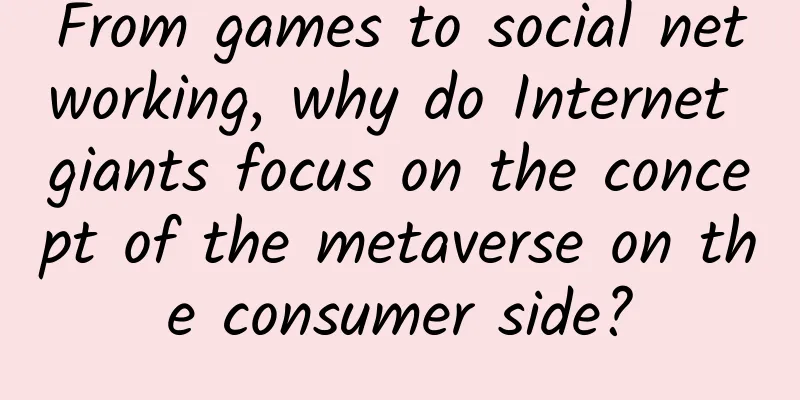From games to social networking, why do Internet giants focus on the concept of the metaverse on the consumer side?

|
Since the concept of "Metaverse" became popular, the two major industries of social networking and gaming have found a new outlet. Let's recall the names that have actively participated in the Metaverse: Epic, Facebook, Tencent, ByteDance... They are either gaming giants or social networking giants, and some are both. Seemingly influenced by science fiction works, the imagination of consumers and the capital market about the metaverse seems to be concentrated in these two areas, including Facebook's "Metaverse Office" blueprint, which is also based on the extension of social networks. Indeed, the Metaverse is ultimately a new form of interaction, and social networking and games are the two most interactive applications in today's online world. But if we only stick to these two paths, it would undoubtedly be a waste for such a grand concept as the Metaverse. There are also companies that have started to implement this technology in other fields, such as VR Education in Ireland. As the name suggests, this is a company that focuses on the education field. VR Education was founded in 2014. Influenced by Oculus, which was still in the crowdfunding stage at the time, VR Education entered the VR field. At first, their goal was to use VR to let people relive the Apollo program or explore the sinking of the Titanic, but as the VR craze faded, they began to think about new ways out. In 2018, they set their sights on education and launched the Engage platform, which provides educators with an immersive teaching experience. The platform can provide educational institutions with a variety of online classrooms and teaching environments, and individual educators can also subscribe to a private classroom for $10 per month and upload personalized teaching content such as panoramic videos and 3D models. For example, if it is an anatomy course, the teacher can prepare a 3D human skeleton to help students understand the content of the class more intuitively; for biology classes, teachers can also make 3D models of DNA fragments, microscopic or abstract concepts. This also makes it no longer just a more fancy Zoom, but truly uses VR and even metaverse-related technologies. For consumers, Engage is even more attractive because it is free. Users only need to pay tuition to teaching individuals or institutions to enjoy all the content on the Engage platform. Engage's services have also been extended to areas such as corporate meetings. Their platform supports functions such as spatial audio, so it can even restore the scene of two people talking to each other in real life. Engage is also the only online conference service platform that can accommodate 1,000 people at the same time. This function was first launched on HTC Ecosystem, and HTC also reciprocated by investing in VR Education. The outbreak of the epidemic since 2020 has put VR Education on the fast track. In addition to schools, companies and other organizations have also begun to purchase their services. In the past year, the total stock value of VR Education has tripled. This year, VR Education's first quarter profit exceeded last year's full-year profit, with a growth rate of 400%. Its customers include well-known companies and institutions such as Facebook, Stanford University and Huawei. VR Education's business has also come to China. The Chinese version of HTC Vive has built-in Engage service, and it has become one of the few VR platforms in China that can operate normally. Now, VR Education has also announced that it will enter the ranks of the Metaverse, and they named it "Engage Oasis". Obviously, this name is taken from the Metaverse platform "Oasis" in "Ready Player One". VR Education CEO Whelan believes that Engage Oasis will become a place for business talks, where senior executives of major companies can connect, explore new cooperation opportunities, and demonstrate each other's value. It can be seen that unlike other giants who are busy in the fields of games and social networking, VR Education is actually targeting corporate customers. For the consumer side, they may not even charge a penny. Today, the popular new stars of the metaverse, such as Roblox, have tens of millions of users worldwide. Even though many of these users are children who can only spend $5 to $10 a year to buy some small props, the huge population base can still support huge profits. The user base of VR Education may not be as large as the former, but it covers groups with stronger paying ability such as business people, enterprises, educators, etc. If Roblox is compared to Tik Tok in the metaverse, then VR Education is more like LinkedIn in the metaverse. In fact, it is common knowledge in all walks of life that B-side users have stronger paying ability. The main income of many giants in today's technology industry also comes from the B-side. But why did the little-known VR Education take the lead in gaining the favor of B-side users in the field of Metaverse? This is largely because they did not create Metaverse for the sake of Metaverse. Since entering the VR education industry in 2018, VR Education has been perfecting related technologies. Whether it is an online classroom with complete teaching functions or an online conference room that can accommodate 1,000 people, their launch time is earlier than the explosion of the metaverse concept. Therefore, it is more logical for VR Education to catch the express train of the metaverse. To put it another way, even if the metaverse does not cause much trouble in the end, VR Education can still win a place for itself with excellent products and services. In contrast, other giants who are vigorously promoting the Metaverse are either relying on old wine in new bottles to ignite the investment market, or just trying to take advantage of the popularity first. This explains why they are all concentrated in the to C field - after all, compared with those old hands in the shopping malls, consumers are much easier to exploit. However, consumers are not stupid either. If they are obsessed with hyping concepts but fail to come up with convincing products, then no matter how loud the initial noise is, it will ultimately end up with no one paying attention. As a winner of Toutiao's Qingyun Plan and Baijiahao's Bai+ Plan, the 2019 Baidu Digital Author of the Year, the Baijiahao's Most Popular Author in the Technology Field, the 2019 Sogou Technology and Culture Author, and the 2021 Baijiahao Quarterly Influential Creator, he has won many awards, including the 2013 Sohu Best Industry Media Person, the 2015 China New Media Entrepreneurship Competition Beijing Third Place, the 2015 Guangmang Experience Award, the 2015 China New Media Entrepreneurship Competition Finals Third Place, and the 2018 Baidu Dynamic Annual Powerful Celebrity. |
<<: Please restrain yourself from playing mini games on WeChat Moments
>>: One picture tells you why Apple's hardware design is so elegant
Recommend
The computer can now post to Moments! WeChat search on PC has also been updated
The PC version 3.3.0 was officially released and ...
The “white spots” that brought the cultural relics back to life are actually plaster?
When visiting museums, we often see a large numbe...
Learn 3 tricks to easily promote your product
Product promotion does not necessarily require &q...
Milk tea is more refreshing than coffee, it turns out it’s due to the different extraction methods!
Every time I go to a mall, there is always this k...
This commonly eaten vegetable actually causes cancer? Doctors recommend eating it this way
But some people always say "Don't eat br...
Expert Tips | Factors that influence inclusion in Xiaohongshu!
Why can't I search for the notes I posted? Wh...
The fragrance of jasmine and the stench of poop are actually the same smell component, can you believe it!
The sense of smell is one of the most important s...
Qinghai school start time 2020 specific time: 2020 spring semester insists on online classes first, staggered start
In order to thoroughly implement General Secretar...
Apple rolls out iOS 14.5 with controversial privacy features
Apple officially released the update for all iPho...
How much does it cost to be a tea mini program agent in Hexian market?
Is it easy to be an agent of Hexian Tea Mini Prog...
If you don't use an air fryer, you will regret it!
When was the last time you used an air fryer? The...
Why did the US aircraft carrier escape from the military exercise in the Taiwan Strait? What is the specific situation?
According to a message released by the US Pacific...
How to play CPA advertising project? Use ad networks to earn revenue!
CPA is a common advertising promotion method at p...
Practical skills and methods for medical bidding promotion!
There are many ways to bid, and no single method ...
Learn event operations from Alibaba: a premeditated "sudden" incident
It is often said in the Internet industry that &q...









